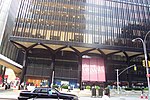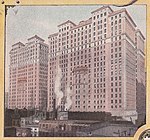International Freedom Center
The International Freedom Center (IFC) was a proposed museum to be located adjacent to the site of Ground Zero at the former World Trade Center in New York City, USA. It was selected in 2004 to comprise a "cultural space" near to the memorial for victims of the September 11 attacks, called Reflecting Absence. However, opponents reacted against the IFC's mission, saying that plans to promote international freedom through exhibits and displays about various genocides and crimes against humanity through history, including genocide of Native American and the slave trade in the United States, were inappropriate at a site that many people consider to be sacred. On September 28, 2005, New York Governor George E. Pataki barred the IFC from the World Trade Center site.George Soros, Tom Bernstein, Anthony Romero, and Eric Foner were promoters of the IFC. Within an hour of being barred from the WTC site, the IFC museum declared itself to be out of business, making no effort to find a new location. "We do not believe there is a viable alternative place for the I.F.C. at the World Trade Center site," said the statement from the center's executives, Tom Bernstein, Peter Kunhardt and Richard Tofel. "We consider our work, therefore, to have been brought to an end."
Excerpt from the Wikipedia article International Freedom Center (License: CC BY-SA 3.0, Authors).International Freedom Center
Greenwich Street, New York Manhattan
Geographical coordinates (GPS) Address Nearby Places Show on map
Geographical coordinates (GPS)
| Latitude | Longitude |
|---|---|
| N 40.711 ° | E -74.012 ° |
Address
3 World Trade Center
Greenwich Street 175
10048 New York, Manhattan
New York, United States
Open on Google Maps










